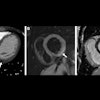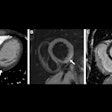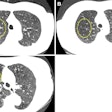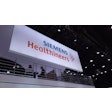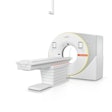Confirming the results of several smaller studies, the multinational PROTECTION III study found that applying prospective rather than retrospective electrocardiogram (ECG) triggering to coronary CT angiography (CCTA) reduced radiation dose by two-thirds without any drop in image quality, according to a study in the May JACC: Cardiovascular Imaging.
In a cohort of 400 patients examined at nine centers, axial scanning with prospective triggering at 64-detector-row CT was equivalent to helical scan protocols using retrospective ECG triggering, but with 69% less dose.
In addition, "the study identified similarly low rates of downstream testing, suggesting that the use of the axial scan protocol was not associated with an increased near-term repeat testing or resource utilization," the authors wrote (JACC Cardiovasc Imaging, May 2012, Vol. 5:5, pp. 484-493).
Prospective ECG-triggered axial scanning, known variously as "step-and-shoot" or "sequential scan mode," was introduced as an alternative to standard helical scanning with ECG gating with the aim of reducing the coronary CT radiation dose, the authors explained. Prospective acquisition applies radiation only at a predefined point in the cardiac cycle rather than during the entire cycle, reducing dose by approximately 60% to 80%, the authors explained.
"Although its use has been increasingly advocated, the comparative effect of coronary CTA using axial versus helical CT data acquisition on image interpretability, image quality, and radiation dose in consecutive adult patients has not been well-established," wrote Dr. Jörg Hausleiter, from the German Heart Centre in Munich, and colleagues.
The main objective of the randomized study was to "demonstrate the noninferiority of an axial scan protocol for coronary CTA" based on image quality compared with conventional helical scanning. The study also aimed to compare radiation doses and the need for additional downstream testing in patients who followed each of the two scan protocols.
Recruitment was limited to patients in stable sinus rhythm with heart rates less than 65 bpm (single-source CT) or less than 75 bpm (dual-source CT), who did not have known coronary artery disease or known extensive calcifications (Agatston score > 800 HU).
Hausleiter and colleagues including Dr. Tanja Meyer; Dr. Eugenio Martuscelli; and Dr. Stephan Achenbach randomly assigned the 400 patients (mean body mass index, 25.9 ± 3.8) to an axial or a helical scan protocol using 64-detector-row CT (LightSpeed VCT, GE Healthcare; Brilliance 64 or Brilliance iCT, Philips Healthcare) or dual-source 128-detector-row CT (Somatom Definition, Siemens Healthcare) following the injection of iodinated contrast agents.
The use of beta-blockers to reduce heart rates was recommended, as was the use of reduced tube current (100 kVp) in nonobese patients. Other low-dose strategies such as the use of automated tube-current modulation were recommended when appropriate.
Images were reconstructed according to each hospital's local practice and as needed for clinical decision-making, the group wrote.
Two experienced readers evaluated all datasets in a core laboratory after images had been randomized and anonymized, examining axial slices, multiplanar reformations, and thin-slab maximum-intensity projections. Image quality was evaluated and scored for each coronary artery on a scale of 1 to 4, with 1 being nondiagnostic and 4 being optimal. Coronary artery contours were also assessed on a "blurring score" of 1 to 4, again with 4 being optimal. Finally, the pair quantified signal intensity, image noise, signal-to-noise ratio, and contrast-to-noise ratio as objective quality parameters.
Image quality in patients scanned with the axial scan protocol (score, 3.36 ± 0.59) was found to be "not inferior" to that of helical scan protocols (3.37 ± 0.59) (p for noninferiority < 0.004).
Axial scanning was associated with a 69% reduction in radiation exposure, with a dose-length product of 252 ± 147 mGy.cm and an estimated effective dose of 3.5 ± 2.1 mSv. This compared to a mean dose-length product for helical scanning of 802 ± 419 mGy.cm and an effective dose of 11.2 ± 5.9 mSv (p < 0.001).
Nondiagnostic coronary CTA studies -- represented by an image quality score of 1 in any coronary artery and mostly due to motion artifacts -- were seen in 13.0% and 11.5% of axial and helical scans, respectively (p = 0.647). Mean heart rates were a little higher in patients with nondiagnostic studies (56.4 ± 6.6 bpm versus 54.5 ± 5.7 bpm) for diagnostic studies. Misalignment artifacts and extensive coronary calcifications comprised less than 2% in both axial and helical groups.
Finally, despite the dose reduction using axial scanning, the rate of downstream testing did not differ significantly between the groups in each scan protocol: 13.8% for axial scanning versus 15.9% for helical (p = 0.555).
No significant differences in image quality were noted between scan protocols or scans by the different manufacturers, the group stated.
"The study presented here provides further support that coronary CTA with lower radiation dose is feasible without compromising diagnostic image quality, when the prospectively ECG-triggered axial scan mode is used," Hausleiter and colleagues wrote.
In nonobese patients, the effective dose was as low as 2.2 ± 1.3 mSv, suggesting that axial imaging is appropriate for comprehensive dose-reduction strategies.
Diagnostic accuracy was not compared due to the high number of enrolled patients it would require, but smaller studies have shown comparable results for the two scanning techniques in that measure as well.
Additional studies are needed to determine performance of the axial scan in patients with higher heart rates, the group added, and whether axial scanning performs as well in patients at high risk or with extensive atherosclerosis also remains to be seen.
"ECG-triggered axial scan technique should be used for coronary CTA in all patients with low and stable heart rates, in pursuit of the ultimate goal of obtaining diagnostic coronary CTA images with the lowest possible radiation dose," the study team concluded.
